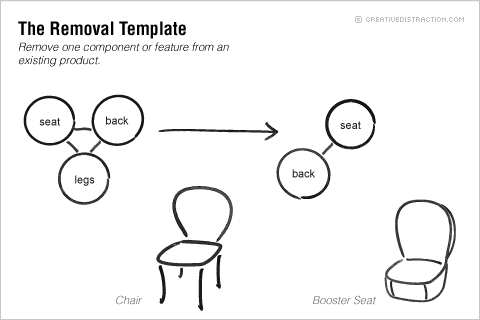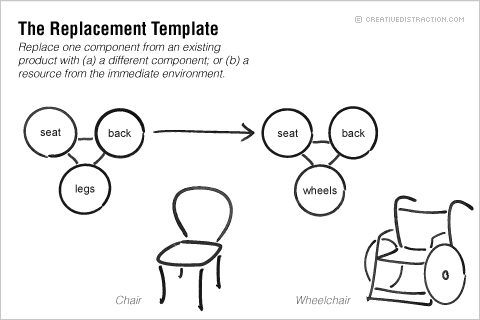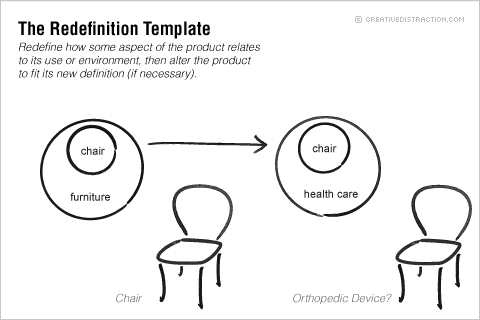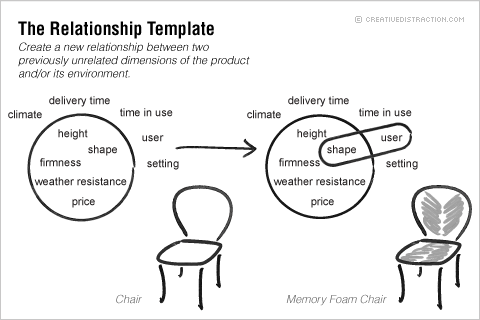“Time to brainstorm.” That’s the signal in most organizations that the real creativity is about to begin. A brainstorm is called upon to rain diverse solutions upon our biggest problems. In the process, our institutional intelligence crackles and evolves, and from out of the murk brilliant new ideas flash — some of them golden, for sure.
But what if brainstorming isn’t always the best way to be creative?
| Skip to the templates | Skip to the free download |
Different as it may appear in different organizations, brainstorming is recognizable everywhere: People work together, not alone. Everyone is encouraged to contribute. The setting is often casual; a “retreat” away from typical circumstances is preferred. All ideas are recognized and recorded. The more ideas, the better. And of course, there are no “bad” ideas.
This is systematic creativity: focused, subject to specific constraints, highly actionable, and can be carried out comprehensively by one or two dedicated individuals
Our preference for brainstorming in our deliberate creative activity says a lot about how we think — or assume — creativity happens. Brainstorming is informal, free of constraints, highly generative, carried out in groups, and open to random and “left field” influences. This format would seem optimum if we believe (1) that people are naturally creative, only our creativity is shackled by routine and demands; (2) that groups create synergy in creative thinking; (3) that judgement must be deferred to elicit the best ideas; (4) that quantity of ideas ultimately yields quality of ideas.
Systematic approaches are different.
In 2002, business professors Jacob Goldenberg and David Mazursky published one such approach in their book, Creativity in Product Innovation, arguing the case for an alternative to brainstorming when the task is to generate ideas for a new commercial product — or a new sales and marketing strategy, for that matter. Using Goldenberg and Mazursky’s “Creativity Templates” approach, we start with an abstraction of an existing product and then iterate through a finite set of “templates” which impose upon it arbitrary modifications. Each permutation is evaluated to see if any plausible evolutionary change has been revealed.
This, my friends, is systematic creativity. It is focused, subject to specific constraints, highly actionable, and can be carried out comprehensively by one or two dedicated individuals. The templates approach, in particular, bespeaks a compelling-but-still-unconventional belief that creativity isn’t all sparks of intuition from naturally creative individuals. Or at least, it doesn’t have to be.
The Creativity Templates
Clearly, “function follows form” in this process, not the other way around. At the heart of the templates approach is a kind of genetic algorithm, spurring mutations in an existing product almost randomly so that we can ask, “Is it better?” If it is, we may well be on our way to a valuable innovation.
Goldenberg and Mazursky identify four specific “Creativity Templates” based upon their abundant research into successful product innovations throughout history. The templates are designed to expose in any product “codes embedded in the product itself and in trends observed in its evolution.” That’s valuable intelligence for anyone in the “product” business. (And really, who isn’t?)
But like many good academic works, Goldenberg and Mazursky’s Creativity in Product Innovation has been criticized for being “too academic” by folks in the business community. As a very modest product innovator myself, I took an interest in adapting Goldenberg and Mazursky’s novel approach to creativity for my own use. What follows is my humble version of the four creativity templates. While I am essentially re-interpreting Goldenberg and Mazursky’s work and owe them all the credit for anything of value here, the flaws and insufficiencies of the below remain my own.
The Process
While Goldenberg and Mazursky offer detailed operational instructions and examples for each template in their book (which make it worth the hefty pricetag!), I trust that each of us can also find our own ways to implement the ideas following this basic process:
(1) Identify the component parts and features of an existing product
(2) Apply the transformations suggested by each template
(3) Evaluate the result: Does the new configuration offer any benefits? Could it appeal to new markets?
(4) Repeat until satisfied
Clearly, “function follows form” in this process, not the other way around. At the heart of the templates approach is a kind of genetic algorithm, spurring mutations in an existing product almost randomly so that we can ask, “Is it better?” If it is, we may well be on our way to a valuable innovation.
The Removal Template
Process: Identify the component parts and features of an existing product. Now, remove one. Does the new product configuration offer any benefits? Keep returning to the original product, removing different components, and asking this question. Consider a simple chair comprised of a seat, legs and back rest. If you remove the legs, for example, you have the beginnings of a new product for children: a booster seat.

Goldenberg and Mazursky call this the “Displacement Template” and define it as “the removal of an intrinsic component from the configuration including its functions, in a way that causes a qualitative change in the configuration.” They have some great examples, such as ready-bake cake mix: When the just-add-water mix was first introduced in the mid-20th century, it flopped. But when it was re-introduced with the powdered eggs removed (so now just-add-water-and-eggs mix), people loved it. Suddenly, baking was easy, but not too easy: the chef still had to add fresh eggs and his or her personal flair.
Note that removal innovations are ideally more than just the “unbundling” of a product to achieve a reduced price, like IKEA’s cheap furniture with all the assembly required. Instead, the new product should offer new benefits.
The Replacement Template
Process: Identify the component parts and features of an existing product. Now, replace one with something else: another component or a resource from the immediate environment. Does the new product configuration offer any benefits? Keep returning to the original product, replacing components and features, and asking this question. Consider a simple chair comprised of a seat, legs and back rest. If you replace the legs with wheels, for example, you have the beginnings of a new product for the disabled: a wheelchair.

The Redefinition Template
Process: Identify the component parts and features of an existing product. Also identify components and features of the product’s use and environment. Now try relating one of the product’s components to a new use or environment. For example, the firmness of a chair can be related to the user’s health as opposed to the user’s décor, allowing us to redefine it as an orthopedic device. Does this redefinition offer any benefits? Keep creating new relationships and asking this question.

Goldenberg and Mazursky call this the “Component Control Template” and note that it is “characterized by making a new link between a component in the internal environment of the product and a component in its external environment.” They cite the example of women’s nylon stockings: As more and more people became aware of what damage UV radiation does to the skin, nylon stockings — which already blocked 80 percent of UV rays — could be redefined as a skin protectant with little in the way of additional product development.
The Relationship Template
Process: List out all the attributes or dimensions of an existing product, as well as the attributes or dimensions of its use and environment, especially the measurable ones (e.g. price, temperature, firmness, etc.). Make up an arbitrary relationship or dependency between any two attributes or dimensions (e.g. as one increases, another decreases). Does the new relationship yield any benefits? Returning to our chair example, consider relating the shape of of chair to the shape of the individual sitter, which could be accomplished with existing technology, such as memory foam. Is this a compelling product?

Goldenberg and Mazursky call this the “Attribute Dependency Template” and describe it as “based on finding two independent variables (i.e., a change in one does not cause a change in the other) and creating a new dependency between them.” Notably, they cite the example of Domino’s pizza: By promising “delivery in 30 minutes or your pizza is free” (or some variation), Domino’s used an arbitrary relationship that was profitable on the whole for the restaurants and helped them win customers over the local competition.
Conclusion and Download
As for whether systematic creativity and the creativity templates are useful tools, I await your comments. For your reference, I have created a downloadable creativity templates cheatsheet (PDF). From my experience with them, it’s still too soon to judge: The templates have certainly helped me prime the creative pump, but an intuitive leap is probably required to generate the very best creative ideas. And certainly a vibrant brainstorm session is still a good way to spend an hour of the workday.
Download the Creativity Templates Cheatsheet (PDF):
